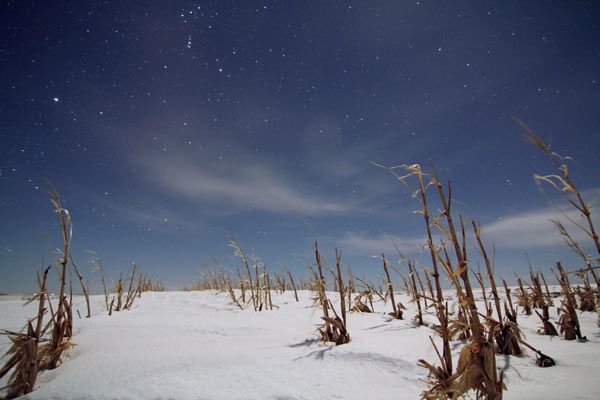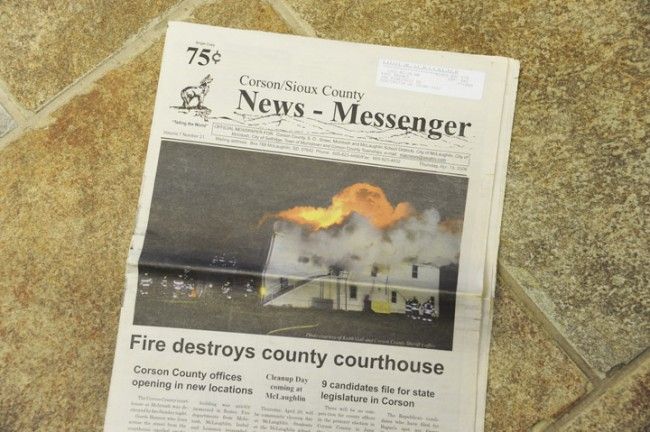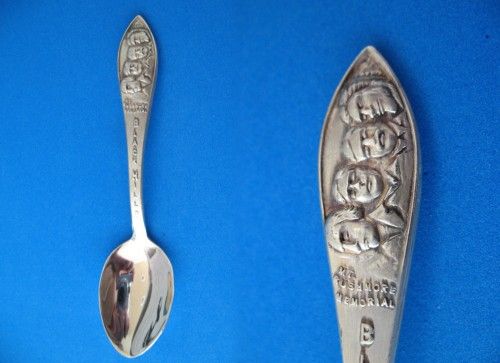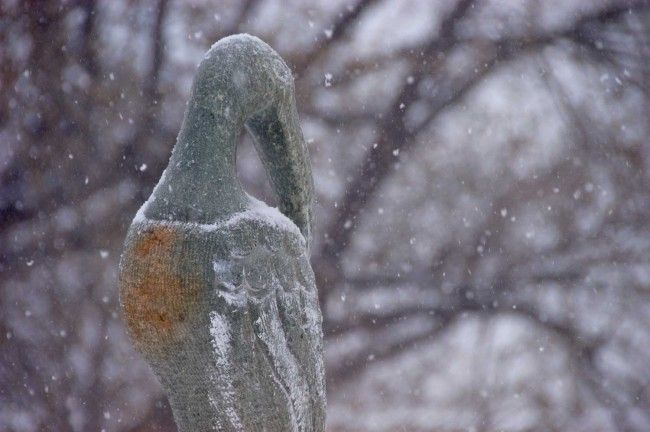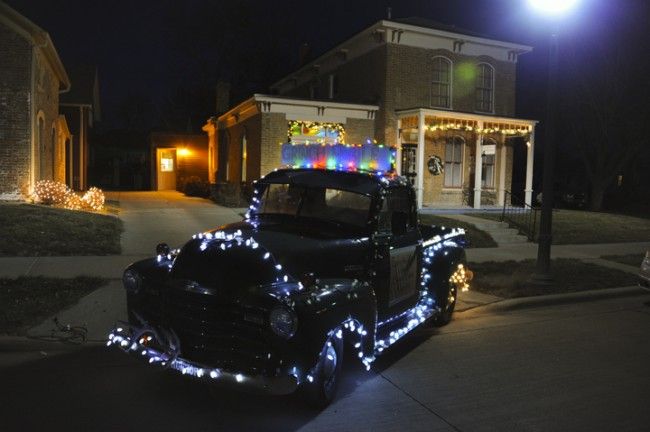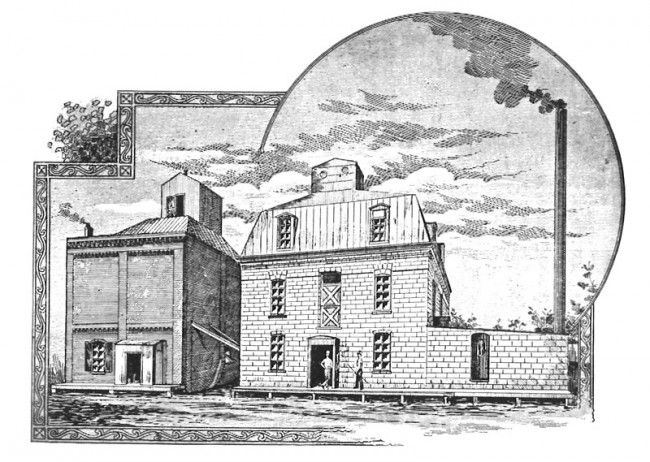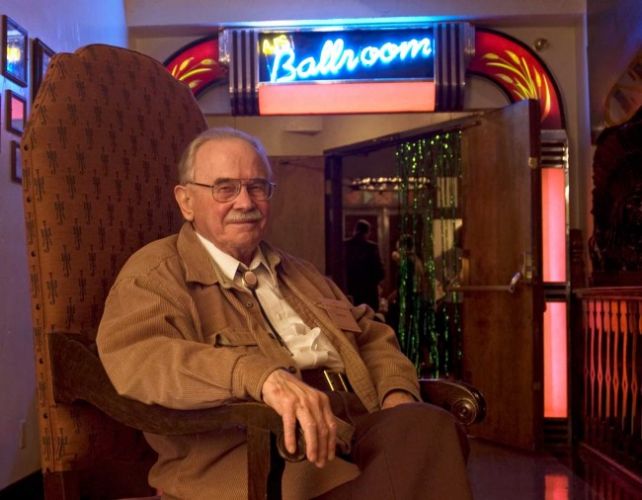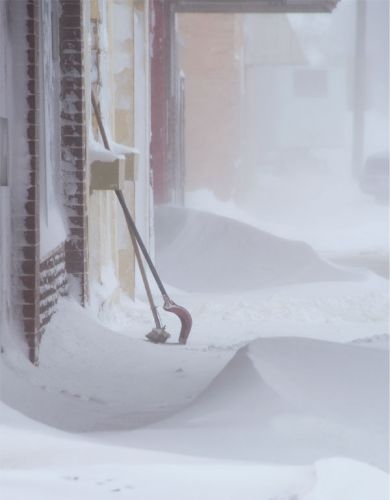
Editor's Notebook
Join our Editor-at-large and founder, Bernie Hunhoff, as he offers stories, quips & travel tips gathered as he roams South Dakota. Other magazine staffers may contribute here or there as well. Enjoy the South Dakota miscellanea.
Video: Sub Zero in South Dakota
February 2, 2012
Lyman County farmer, Randy Halverson, was featured in our current issue of South Dakota Magazine for his stunning images of South Dakota's night sky. His keen eye and sophisticated equipment allow him to capture details that are rarely seen by the naked eye. His favorite technique is long exposure photography, which is then incorporated into time-lapse videos.
Almost a year ago to this date, Halverson set up his camera near his Kennebec farm during a brutal cold snap. Wind chills plunged to 25 below zero, and Halverson had to regularly place his cameras and computer equipment in coolers filled with hand warmers to keep frost at bay and the electronics functioning. The starry sky, low wispy clouds racing across the horizon and frozen landscape, illuminated by the bright white light of a full moon, created an eerie scene.
You might want to put on an extra blanket before you watch it.
To see more of Randy's videos, visit his website, DakotaLapse.
A New Flag for South Dakota
January 24, 2012
South Dakota needs a state flag, and this week more than 80 of the 105 lawmakers introduced a bill to adopt a design. (I should make a concession that may surprise some South Dakota Magazine readers — I work "nights" as a state legislator from Yankton, and I am one of the sponsors.)
You’re thinking we already have a flag, and in a sense we do. For years, our Great Seal has doubled as a flag symbol. We all like the seal — which shows a riverboat, a farmer and wheat fields — but a seal is not a flag.
The United States of America has a seal, but we also love the Stars and Stripes, and Old Glory unifies us as a people. Texans have a Great Seal, but they proudly fly the Lone Star.
South Dakota had a real flag more than 100 years ago. A sunburst on a bright sky blue background was created in 1909. But somewhere along the line, an efficient bureaucrat decided to fill the backside of the flag with the seal. Then another bureaucrat decided it was too cumbersome to print the seal on one side and the flag on the other, so he dropped the flag symbol.
Way back when South Dakota celebrated the state centennial in 1989, artist Dick Termes of Spearfish began to contemplate the need for a flag for South Dakota. He did some design work, but he also created the famous Termesphere and since then he has become firmly established as one of the greatest artists in South Dakota history.
Termespheres now hang in many of our state and country’s finest galleries and buildings, and Dick Termes has achieved international acclaim.
But Dick continues to live and paint from a small, humble studio outside Spearfish and he would like nothing more than to give South Dakota a flag that could help promote pride in our state. He wants nothing in return other than that.
I’m proud to work with other legislators to try to adopt his design as our flag. Some people ask why we don’t open it up to competition. If we did so, we would receive hundreds of designs and the 105 legislators would each have a favorite — many times their favorite would be the design by their brother or neighbor. But few of the other artists would have Dick Termes’ skill, and none of them will have spent 20 years thinking about what a great flag should be.
The proposed flag gives a nod to the 1909 flag, featuring an abstract sunburst on the same sky blue background. It also features a medicine wheel, a cultural symbol of our oldest residents. The medicine wheel represents the four directions of the Earth and the great outdoors that we all love.
This won’t be an easy sell, even though we have 80 co-sponsors. There are more opinions on flag designs than on merit pay and gas taxes.
We won’t spend a lot of time on it. I’m sure some citizens complained when the U.S. Congress adopted Old Glory, but I’m glad they took the time. The budget, education reforms and economic development are our priorities and they will come first.
But we will find time to try to make a good decision on the proposed flag. I like it. I’m sure that many people won’t. We all know the controversies that erupt when our favorite school changes mascots or our car companies come out with new designs. I still like the ’57 Chevy.
So this may take some getting used to. If you like it, I hope you’ll help by contacting your local legislator. If you don’t like it, take another look … and another. It might grow on you.
The Day the Courthouse Burned
January 16, 2012
Courthouses are second only to churches as the most important buildings in 66 South Dakota cities. That's where we go for marriage licenses and birth certificates. It's where we register to vote, and for the draft. It's where we pay our taxes and buy our license plates and complain to the county commission.
Most of our courthouses are built of stone and brick, and some may outlast the coliseum in Rome. But a few were built of wood and they are more susceptible to the whims of man and nature.
The citizens of Corson County are still saddened by the events of April 1, 2006 when their old, wood-frame courthouse in McIntosh erupted in flames shortly after midnight. Firemen from McIntosh, McLaughlin, Isabel and Lemmon rushed to help, but the dry old building burned like straw. By morning, the county's five vaults were standing solidly amidst the smoking, smoldering rubble.
Contents in the vaults were soggy and sooty, but intact. Everything else was lost.
Karl Brooks, a Corson County native now living in West Virginia, sent us the Corson News Messenger that was published a few days later. He also sent the June 8 issue which announced the arrest of Dwight "Trey" Crigger, a drifter from Texas who came to South Dakota with a combine crew and was hired by the county weed board.
Crigger, 25, a member of the McIntosh fire department, was also charged with an earlier fire at the county shop. "If Crigger started the fire," wrote the editor, "some of his actions are puzzling. He had worked hard on restoring the pickup used for spraying the by the weed and pest board. It was parked in the shed that burned and destroyed. Maps he had prepared showing noxious weed locations were burned in the courthouse fire."
The young man confessed to the crime and was sentenced to 15 years in the state penitentiary, and assessed $1.1 million in damages. He never explained why he torched his adopted town's beloved and historic courthouse.
Ethan Needs Us
January 11, 2012
We've dropped by Cook's Inn in Ethan more than once through the years. The little Main Street eatery has been operated for many years by Marilyn Thill. It was just another small town restaurant to me, but it was much more than that to the locals.
It took several visits for me to understand that Marilyn and her restaurant were a lifeline to many folks in the little town south of Mitchell. She stocked a few grocery staples for senior citizens who had no other access to groceries. She delivered meals to home-bound neighbors — a Meals on Wheels without the paperwork or fuss. Free cookies and candies were often left on the counter for people who were in too big of a hurry for a meal or for kids who didn't have a dollar but needed a snack.
Hanging on the back wall was Helen Garvis' spoon collection. Helen was a beloved local farmwife who liked to collect spoons as she traveled. When she died, Marilyn bought the spoon collection because she thought it should be kept together. She hung it in the restaurant, and Helen's friends found a lot of comfort in being able to see the spoons when they visited for soup or a sandwich.
Of course, nothing continues forever. Marilyn has been past retirement age for a few years now. She didn't want to leave the town without a restaurant, so she was happy to lease it to a fellow before she stepped away.
Unfortunately, the man who leased it to didn't have her business acumen — and he soon abandoned the place in a condition that is unfit to operate. Marilyn wants to reopen it but she doesn't have the cash to do the repairs. Recognizing all she did through the years for the community, two local men have begun a fund drive to raise about $1,000 for the needed improvements. Mel Weber of Mitchell and Dennis Puepke of Parkston told the Mitchell Daily Republic that anyone interested may send a few dollars to the Farmers State Bank in Parkston. They don't expect anybody to send a lot ... but if you want to do a small kindness (the kind Marilyn did every day she was at the restaurant), send $5 or $10.
We'll let you know if she gets it reopened. Then we can all stop by for a cheeseburger and see Helen's spoons.
Pierre's Paper Soul
January 10, 2012
Many people consider an independent bookstore to be the heart and soul of their community. That seems to ring true in downtown Pierre, where the Prairie Pages Bookseller was recognized Monday night as the South Dakota Retailer of the Year.
Last summer was harrowing for all of Pierre's downtown businesses. To ward off the flooded Missouri, sandbag barriers were built on both sides of the street. Sinkholes appeared on downtown streets, some big enough to swallow a tiny car. To make matters worse, the odor of diesel fuel permeated the street because the high groundwater mixed with some long-buried diesel tanks.
Peggy Stout and Kathy Villa, the proprietors of Prairie Pages, exemplified the plucky Pierre business establishment. They bravely carried on with book signings, readings, book clubs and other activities that gave literary children and adults a place to gather and share their love of the written word.
It was a crazy summer, but somebody noticed their resilience. On Monday night, with a banquet hall full of lawmakers gathered on the eve of the State Legislative Session as well as fellow retailers from around South Dakota, Peggy and Kathy stepped forward to accept the Retailer of the Year honor.
They credited their readers for making the store possible. "You are the store," said Peggy. Maybe so, but somebody needs to oversee the day-to-day duties — things like choosing the books, paying the light bill and stacking the sandbags.
Danger: Thin Ice
January 6, 2012
The other day, a nice dog fell through the ice on the James River just east of Yankton. Rescuers were able to get him out alive.
We're hearing stories like that every day. Debbie Hemmer of the Grant County Review reported this week that ice shacks are falling through the ice into Big Stone Lake, and huge parts of the lake are now open. Randy Stuckey, whose family ran the Bay View Resort for nearly 30 years, said he's neer seen anything like it.
Apparently, a husband and wife on an ATV fell through the ice on Goose Lake. They were also pulled to safety.
GF&P officials recommend that ice fishermen not venture onto the lake alone. The 50-degree January days can melt the ice in a hurry.
I just got off the phone with Gary Block of Waubay, a Day County commissioner and jack-of-all-trades. He was in an ice shack on Bitter Lake. He says the ice there is a foot deep so he thinks he's safe.
"Oh, I gotta go. A fat perch is biting," he said.
Enjoy the winter, everyone. But you might want to wear a life jacket instead of a parka.
Why We Love Railroad Depots
December 28, 2011
Railroad depots fill a special place in the hearts of small-town citizens who remember memorable visits to the station. Maybe they collected a box of Christmas gifts. Maybe dad came home from war. Or grandparents from afar came to vist. Or the youngsters boarded a train that took them on a school trip to the great world beyond their cornfields and cow pastures.
So it's not surprising that Fort Pierre residents want their 1906 depot back, even though it was moved to the Miller ranch near Mud Butte in 1964.
Lance Nixon of the Pierre Capitol Journal reports today that over $125,000 has already been raised by the Verendrye Museum to re-relocate the depot. Museum board members think the total cost may be five times that number.
Big-city depots have often been reborn as restaurants, bars and offices. The best example is in downtown Mitchell.
New purposes for small-town depots have been harder to find, so we've lost a lot of them. Our old wood depot at my hometown of Utica suffered a slow decay until the men behind the Menno Power Show moved it to their frontier town and restored it. Thankfully they left the station sign that reads UTICA.
And thankfully for Fort Pierre, the Miller family has mothballed, so to speak, that town's depot for nearly 50 years. Now its next stop is Fort Pierre.
Surviving a Warm Winter
December 27, 2011
A wave of 29,000 Norwegians immigrated to America in 1882. Most ended up in the Dakotas, and we are benefitting from that infusion of common sense once again this winter.
I’m reminded every time I go to the post office or to Gramp’s coffee shop.
“Nice weather, huh?” someone will say.
“Yes but we’ll pay for it,” replies someone else of Norwegian descent.
Norwegians know that the secret to surviving winter is to not let oneself feel too happy or too sad. A really tough winter — the sort we suffered in 2009 and 2010 — tested our low ebb. Thus far in 2011, we run the risk of feeling too good.
But if you come from a country where darkness settles over the landscape for 60 days — a land where they believe that there is no bad weather, only bad clothing — you accept a 55 degree December day almost the same way you would endure a biting blizzard.
I am everything but Norwegian, but I admire the culture of humility, modesty and practicality. Thus I know that the best way to cope with these beautiful winter days is to pretend they are not occurring.
When someone at Gramp’s says, “How about this weather!” I’m going to tacitly suggest — maybe only with a nod or a roll of the eyes … maybe only with one eye — that it could be warmer. Or colder.
Why We Print 50,000 Magazines
December 22, 2011
The Christmas season is glorious for many reasons. It's heart-warming to see how our fellow South Dakotans respond to needs at food pantries, community holiday feasts, toy collections and other such projects.
South Dakota Magazine also benefits from the generosity of our people. When we started the magazine on a shoestring 27 years ago, we stumbled along through a slow year. We went door-to-door to sell enough subscriptions to qualify for a second class mailing permit from the post office.
I had a few cows in those days, and I was wondering, as winter approached, which one to sell to pay the next printing bill. I was figuring on the fat one that ate the most hay.
Then came Thanksgiving, and somebody walked in the office door and asked if he could buy a subscription for his brother in Iowa. I was busy with something else, but I politely said I couldn't think of any law against it. Silently, I was thinking that this would be a little extra work for me. Then he asked if we had any kind of gift card to give his brother. We didn't.
A few days later, a nice lady came in and bought subscriptions for all her children. "I want to make them homesick for South Dakota," she said.
Soon other folks started to interrupt our work by calling on the telephone and ordering subscriptions. We soon coined an original phrase — "gift subscriptions" — and we even printed some cheap little postcards to send to the recipients.
The fat cow got to stay on the farm. The printer was paid in full by New Year's Day. And those pesky gift subscriptions are a big reason why South Dakota Magazine is now the biggest statewide magazine on the Northern Plains.
This year we have been busy processing gift subscriptions for weeks. Our press run for the Jan/Feb issue is 50,050 — a new high. And we owe it all — not to udders, as the late Richard Kneip liked to jest about people in the cow business — but to you, our loyal readers who continue to help us find new readers.
Merry Christmas to each and every one.
Grandpa The Bank Robber
December 19, 2011
I still chuckle about the family historian who wrote many years ago that her grandpa was a well-known fellow who died quite suddenly from a neck injury suffered from falling off a horse. It seemed he had just given a very short speech in the shade of a tree in the town square when the horse bolted.
The historian didn't add the fact that her grandpa's neck somehow became tangled in a rope that was tied to a tree branch.
But I shouldn't be amused because the executed man was somebody's grandpa. He must have done something bad. Maybe he stole a horse. But he probably did some kind deeds. If nothing else, he fathered a child who had a child who cared enough to try to whitewash his reputation.
I'm reminded of all this because our Nov/Dec issue featured a very popular article we called "Outlaws and Scofflaws of South Dakota." I've always wanted to use the word Scofflaw on our our magazine cover, and finally after 27 years of publishing we found the opportunity.
The story has been a big hit with most readers, but we've heard from a few family historians who are not pleased that we presented great-uncles and grandmas in such a dark light. Just this morning I received a letter from a woman who wrote, "While I've become acccustomed to (name withheld) being portrayed in a negative light, he did a lot of positive things during his years in the Black Hills."
Point made. Every South Dakotan — every man and woman who ever lived — is more complex than could ever be explained in a few paragraphs of a family history book or in our magazine. So enjoy reading about our outlaws and scofflaws, but let's all remember that many of them were husbands and fathers and friends and neighbors, and that their good deeds might have more than compensated for the banks they robbed, the horses they stole or the worthless mines they sprinkled with gold dust.
Oldest Beer Joint in South Dakota
December 15, 2011
If anyone is serving beer in an older building, let us know. But we figure that the Excelsior Mill in downtown Yankton probably takes the cake.
Two brick and stone structures were built in 1872 as a flour mill. Several hundred bags of flour were milled, packaged and shipped both east and west to prairie farm towns, forts, reservations and eventually to gold miners in the Black Hills.
Yankton was alive with manufacturing in the 1870s. Factories were set up to make beer, bricks, soap, combs, cigars and other goods.
Eventually, the flour mill became part of the Gurney Seed & Nursery complex, and local entrepreneur Paul Lowrie took over the buildings when Gurney's closed. He has been laboring to find appropriate uses for the sprawling space by the Missouri on the south edge of Yankton. Several years ago, he created a popular nightclub called The Landing, and now the Old Mill — a few doors away on Capitol Street — has also opened as a tavern on Friday nights.
It's not fancy. Utility company spools serve as tables. You can toss peanut shells on the ancient wood floors. The brick and beams are visible, and you can almost smell the wheat. Or maybe that's the beer?
But it immediately ranks as one of the most historic places in the West where you can enjoy a cold brew.
Eventually, the Old Mill will be open more often. Live music is planned, and the menu will expand beyond brats.
Can You Hear Corn Grow?
December 14, 2011
Got any questions about the outdoors in South Dakota? Our online friends are our best editorial advisors, and we need help once again. We're working on a story for our March/April issue that will seek to answer the questions every South Dakotan has asked him/herself.
Can you really hear corn grow? What do you say to a mountain lion? Where's the deepest water in our deepest lake? How do you catch crawdads? Do the donkeys in Custer State Park ever bite? Classics like that.
Got any questions you want answered? Let us know.
You can just comment below, or email bernie@southdakotamagazine.com.
By the way, I'm convinced you can hear corn grow on a very still August night.
How Palmer's Gulch Raised a Professor
December 12, 2011
Ruth Ziolkowski once told our writer Paul Higbee that she doesn't feel a need to travel outside the Black Hills because "anybody you could ever want to meet will eventually come here."
The attraction of outsiders to our mountain valleys also explains how Watson Parker, a child of Hill City, became professor emeritus of history at the University of Wisconsin. Watson is also the author of several books, including the hiker/cult classic "Black Hills Ghost Towns." He is one of your very favorite South Dakotans, unless you don't know him. And last but not least, he was inducted into the South Dakota Hall of Fame a few weeks ago.
A few years ago, Watson explained to me why he aspired to a career in academia. "In the 1940s my family was running Palmer Gulch Lodge near Hill City," he said. "We generally had a lot of vacationing professors from the University of Minnesota, so after-dinner converations on the terrace were learned and lively.
"Chief among the professors was Richard M. Elliot of the psychology department. My dad had known him at Dartmouth, where they were classmates. One evening when I was about 10 years of age, Dr. Elliot and a fellow academic were discussing Roman history. One of them quoted Cato the Elder as saying, 'delando est Carthago,' to which another raised an objection, insisting that he'd really said, "Carthaginem esse Delendam.'
"They began a spirited discussion in Latin and I listened with my ears wide open, and my mouth, too," Watson said, "for there, in the heart of the Black Hills, a whole new vista of knowledge, learning and wisdom was opened for me."
Welcome Randy Tiedeman, Subscriber 44,000
December 8, 2011
We started South Dakota Magazine 27 years ago. I can still remember the first person who subscribed. Bob Abbott (now of Sioux Falls) stopped at my house to tell me about a travel bus business he was developing. "What are you doing these days?" he asked.
"I think I'll start a magazine about life in South Dakota," I answered.
"Sign me up," said Bob, who eventually founded Abbott Travel in Sioux Falls. So I took his address and said I'd bill him when we had some stationery (remember stationery?).
I also remember the first check we received from a subscriber. I'd sent a mailing to bankers and other professionals around the state, pitching my magazine idea and asking for subscriptions. Ron Williamson was then running Citi-Bank in Sioux Falls, and he responded almost immediately with a $9 check.
A big Republican contest for governor was developing as I was planning the first issue. George Mickelson of Brookings and LeRoy Hoffman of Eureka (both candidates, of course) soon sent checks and kind notes. Sadly, South Dakota lost both George and LeRoy too soon — but the Mickelsons and Hoffmans are still supporters and readers.
Why the trip down memory lane? We reached 44,000 subscriptions this month — a very gradual 27-year climb that has defied gravity, the internet and all other hoops and hurdles that every business must manuever.
That 44,000 translates into about 150,000 readers around the USA.
One interesting revelation about reaching a new milestone is the fact that we still get as excited about a new reader as I did when Bob and Ron and George and LeRoy subscribed 27 years ago.
So who's the newest subscriber? He is Randy Tiedeman of Flandreau. Like Ron, he responded to a mailing we did — and here's the kicker. Instead of playing the regular $19, Randy rounded it up to $20.
Readers and supporters like Randy — and 43,999 others — make us feel like the luckiest editors on Earth. Our thanks go out to all of you.
My staff and I hear and enjoy a lot of kind words on what the magazine does to explore and interpret life in South Dakota. But we never forget that the real leaders of this magazine are the readers.
A Stereotypical Plainsman
December 7, 2011
By Bernie Hunhoff
"George McGovern is not your typical South Dakotan since he's a Democrat deep in the red zone," writes Mark Bittman in the New York Times this week. "But he's got the combination of humanitarianism, compassion, idealism and utilitarianism that seems common to people born of the prairie."
Bittman is a food writer for the Times, and his essay (titled "The Wisdom of George McGovern") focuses largely on McGovern's life-long effort to curb hunger in the world. McGovern was a bomber pilot in WWII, and he volunteered to keep on flying after the war so he could drop food to the very people that we were dropping bombs on days earlier.
The old senator is now 89, and took a nasty fall last week that resulted in hospitalization in Sioux Falls. Word is that he's back on his feet and ready to resume writing, traveling and speaking. He wants to stay alive and active, he says, because he knows that he can use his stature as a senior statesman to help feed the world's poorest people.
Not many South Dakotans have ever received such friendly attention in the New York Times. Bittman's essay will make you proud regardless of your politics.
Yes We Can. No You Can't.
December 1, 2011
Yes, I'm a part-time politician. But I've always tried to not be a Corps-basher. I know a lot of good and caring people work for the big bureaucracy that dammed our favorite river. Many of them are friends and neighbors here in Yankton.
But only one word comes to mind to describe the two-hour meeting on Wednesday night (Nov. 30) at the Kelly Inn, a rifle shot away from the wild Missouri.
That word? Frustration.
Four Corps engineers came to report on a six-year study of the sedimentation problem on Lewis and Clark Lake. The lake was 25 miles long when Gavins Point Dam was built 60 years ago. Today it is 17 miles long. The upper portion has become a delta (the Corps word for it), or a swamp in layman's language.
Some 2,400 acre feet of water storage has been lost, which compounded the flooding this summer. That represents 22% of the lake's total capacity.
Sedimentation has already affected fish and wildlife species and the overall ecosystem. It will eventually damage water recreation and economic development. It is a serious problem.
So a hundred people — most of them, knowledgeable river rats who love the Missouri — gathered at the inn hoping for a vision. For answers. For leadership.
So at last comes the Corps study on sedimentation. Yes, we can flush the lake and remove sedimentation, said Paul Boyd, a hydraulic engineer. We can remove the silt and clay. The sand? That's another matter. It's really hard to move the sand out of the reservoir.
Paul Boyd speaks for an hour, showing graphs and charts of the computer modeling.
Then an old-timer in the rear of the room stands up and drawls, "How much of that .... delta ... at Springfield is sand and how much is silt and clay?"
It's mostly sand, said Mr. Boyd.
Furthermore, the lake would have to be almost entirely drained, then flushed with huge releases from Fort Randall Dam, and then refilled — all in a three-week cycle that would entail discharges of 88,000 to as high as 176,000 CFS. The latter is higher than the highest discharges this summer that overwhelmed the river valley, ruined farmland and destroyed homes and gardens. All of that to remove the silt and clay, which really isn't the problem.
There were not that many more questions. I am sure that everyone in the room — even those most in support of a sedimentation solution — were silently thinking, "is this all there is ... after a six-year study?"
The engineers stressed that they only asked the question of whether flushing would work. They didn't study the social, political, economic and environmental aspects.
I imagine that will take four more studies at six years each.
This is a country that built the Missouri River dams a scant two generations ago. We won two world wars and a cold war. We invented the threshing machine and the automobile and the internet. We made free education and home ownership not a dream but a right. And today it takes our federal government six years to say yes, we can flush the lake and flood your homes if you want us to?
Is it any wonder that we can't solve health care and school issues?
We need vision, both from the politicians and the bureaucrats. The hundred people at the inn were hungry for a path to progress. They left the room hungrier than when they came.
It reminds me of a study done in the late 19th century on how to solve the horse manure problem in New York City. Experts studied the problem and came to the conclusion that there were no reasonable solutions other than to reduce the size of the city population.
The Corps of Engineers needs to find a Henry Ford.
She Shoots Like a Girl
November 28, 2011
By Bernie Hunhoff
It takes a lot of people to produce and publish South Dakota Magazine, about a dozen to be exact. And we're proud of every one of them — both for what they do during work hours here at 410 E. Third Street, and also for all they do after hours.
Our staff includes two yoga instructors, a marathon runner, several great chefs, a hockey mom, a Girl Scout leader, etc. They are also dedicated community volunteers, super moms and dads, and all their children are above average. You get the point.
But we have only one deer hunter. That would be Jana Jonas Lane, a mostly-quiet and reserved young lady who runs our circulation department. If you get the magazine by mail (as most of our readers do) then you can thank her, because she manages our 43,000-name mailing list.
Jana and her husband Jim have two young daughters, so you can imagine how busy she is. She occasionally likes to do a little hunting, but Jim teases that she "shoots like a girl." He hasn't said that for a week now.
The story goes like this. All the local hunters east of Yankton have been watching and waiting for a big 5-point buck that appeared on game cams in the Jim River valley over the summer. The whitetail was very cagey, and wasn't often spotted in daylight.
On opening weekend of the East River season, Jana spent a few Saturday hours in the cold and howling wind, wondering why she wasn't indoors with her two little girls, Rain and Rose. She saw a few does and a big buck with a broken antler, but eventually she went home to warm up.
Sunday dawned with a shining, warm sun. The wind was down and pheasants were cackling. Geese were flying overhead. "It's amazing what sunshine will do for the soul after a cloudy day," she said. "I saw a couple of does pass through our CRP and I looked over and saw a really nice buck as he was headed into a tree line." It was the big Jim River buck!
She says her heart started racing, and she told herself to relax and be ready. Minutes passed but he didn't reappear. Meanwhile, a second buck walked by. It stopped to watch something. Then a doe appeared and crawled through the fence between a pasture and trees. The second buck chased after her.
Jana heard crashing sounds and saw a blur of motion in the switch grass and big blue stem. Eventually, the big buck appeared. He paused about 150 yards in front of her.
Then a young buck came along. It looked at Jana and slowly walked into the trees. A fourth buck came along, chasing after a doe, and they disappeared into the tree line.
Jana took aim at the 5-pointer, through the scope of her .308 Remington, and fired. Just like a girl. She got the Jim River buck.
She's not a braggart, but nothing's stopping the rest of us from telling everyone we can.
Is It Cheaper To Live in South Dakota?
November 25, 2011
By Bernie Hunhoff
Politics are often cussed at Hunhoff holiday gatherings, and as many South Dakotans know, my extended family covers the ideological spectrum.
I happened to tell the clan of a fellow I know in Pierre whose home was heavily damaged by the flood. He was a state employee with a good job, but he couldn't get financing for a home "improvement" loan, even if the improvements were necessities like new sheetrock and flooring. So he told the bank to just keep the house and he left the state for a better-paying job.
"Well, that could be any of us," said one of my kin. "We could all get higher paying jobs elsewhere. But it's cheaper to live here."
Maybe I accidentally rolled my eyes, but I didn't argue because, after all, it was a holiday gathering and I was eating free.
But between you and me, I just haven't noticed that K-mart prices its lawn chairs and cranberry juice any cheaper in South Dakota than the rest of the country. It's well-documented that housing costs are on par with all but the high-cost areas of the USA, unless you live in one of those cool little West River towns like Fairfax or Bonesteel where the fishing is great and you can still get a decent old house for $12,875. Our energy prices were once lower, but they are catching up with the rest of the nation.
But what do I know. So I checked it out online, and soon came to this 50-state comparison. Of course, I was right ... and fortunately I am the only one in my family with a Web site — so I get the last word.
Check it out. South Dakota ranks 28th in cost of living — about in the middle of the pack. I was surprised to see that according to this data base, Nebraska is far cheaper. So are neighboring states Iowa and Wyoming. We are basically tied with North Dakota and Montana.
Wages are considerably lower in South Dakota. We generally rank around 50th in that category, so people working for wages are likely being squeezed here. Business owners, farmers and ranchers may or may not feel the same pressures, depending on their industries and their luck.
You know that we normally like to shed as nice a light as we can on life in South Dakota. But we also don't think it benefits anybody when we perpetuate a myth. If you take taxes into account (which this particular comparison doesn't seem to do) then South Dakota's ranking would probably improve somewhat. But not for the working man or woman, because they pay a far higher percentage of their pay in taxes than their wealthier neighbors.
And if you took taxes into account, then you'd want to also tabulate a hundred other things — like the fact that our technical school tuition is among the highest in the country. We are one of the only states that do not help low income students get a college education. One of the few that does not assist local communities and poor families with pre-school. Etc., etc. There's a flip side to being a low-tax state. So perhaps this comparison (which leaves out taxes) is one that might actually help the Hunhoffs to avoid family arguments. Or even eye-rolling.
South Dakota is a beautiful place to live. We don't need to perpetuate myths to make it seem even better.
Walk On Water in Yankton
November 23, 2011
Now the historic bridge will be a pathway for joggers and walkers, baby carriages, bicyclists, skateboarders and the like. It is the longest pedestrian bridge in the USA that connects two states over a major river. The Newport Bridge, an 1896 railroad bridge that links Kentucky and Cincinnati, had that distinction until today. It is 2,670 feet long, and was redone for foot traffic about a decade ago. The Meridian easily surpasses it at 3,013 feet. The third longest is a new structure, the Bob Kerrey Pedestrian Bridge, built to connect Omaha with Council Bluffs, Iowa. It measures 2,224 feet.
Today at 3 p.m. the Meridian Bridge will be re-opened to the public after being closed for three years. But the bridge will never see another 18-wheeler ... and it isn't even likely to carry a compact car.
Eventually, Yanktonians and Nebraskans hope that walking/biking paths will connect the Meridian Bridge to the bridge over Gavins Point Dam, about four miles to the west. A path already exists on the South Dakota side, and Nebraska officials are making plans for theirs. The 12-mile loop would instantly become one of the most unique trails in the USA, taking hikers and bikers past eagle roosts, quaint restaurants, a sailing marina, small farms and forested river bottom. City officials in Yankton also hope to design and build an attractive plaza at the foot of the bridge.
The Meridian is one of the very few double-decker bridges in the nation. It took its name from the Meridian Highway (US Hwy 81) that cuts through the Americas from Winnipeg to Panama City. Yankton citizens took it upon themselves to fund and build the bridge in 1924 because they thought state officials were too slow in getting the project started. They paid for it with tolls until the debt was retired in 1953.
The bottom deck was intended for rail traffic, but a north-south train route to Yankton never materialized, so officials sent northbound traffic on the top and southbound traffic below. Its classic towers were designed with hydraulic lifts to allow ships to pass underneath. However, ships have been as rare as trains.
Cars and trucks traveled the bridge to the tune of 5,000 or more a day until a new bridge was completed in 2008. Historians on both sides of the river objected to having the old bridge destroyed. In fact, local leaders agreed that they would settle for a plain design on the new bridge so long as the savings were directed to preserving the Meridian as a footbridge.
So beginning this Thanksgiving week, after a very long wait and $4 million or more of your tax dollars, the old Meridian will once again carry traffic. Now you can walk on the Missouri without getting your feet wet.
We hope to see you there.
Sioux Falls Without a Shovel
November 21, 2011
One of my brothers recently moved with his wife to Sioux Falls to live in a townhouse on South Tomar Road, and I'm worried about him.
I went to see him last week and he showed me the beautiful home with its secret closets and cathedral ceilings. It is wonderful. But then he told me that "they" do all the yard work and scoop the sidewalks. He sold his snowblower and his shovels. He's even going to trade in his four-wheel drive SUV.
He's a tough guy. He once outran terrorists in Libya. He knows Judo (or Karate, I can't remember which). And he can shoot the eyes off a potato at 200 yards. But is he going to be prepared for January?
Surviving winter is all mental. We've learned that at South Dakota Magazine from the hardiest survivors of our state. You stockpile all the sweaters, gloves, boots, hand-warmers and hats that can be found. You have enough machinery to clear the airport, or you drink beer with someone who does. And you have access to a vehicle that looks like those contraptions in the Antarctica sci/fi movies.
Then you get it in your head that you can dig and drive your way out of whatever comes.
My favorite story (we've told it a 100 times, so just shut up and laugh) is about the North Dakota farmer who lived on the state line. One autumn, the state transportation department came to his door and told him he didn't live in North Dakota, according to a new survey just completed. "Your land is actually in South Dakota."
"That's good," he replied. "I don't think I could take another North Dakota winter."
That man had lost his mental edge. He was probably playing pinochle in a trailer in Texas by the following November.
Don't worry about my brother. "They'll" take care of his sidewalk, and we'll keep an eye out for him, too. But I sorta wish he would have moved to Nebraska if he's going to go soft.

